Dynamics of Rural Economy: A Socio-Economic Understanding of Oil Palm Expansion and Landscape Changes in East Kalimantan, Indonesia
Abstract
1. Introduction
1.1. Background
1.2. Problem Setting
2. Methods
3. Results
3.1. Oil Palm-Driven Land-Cover Change
3.2. Dynamics of Rural Landscape
- (1)
- Primary forest, dominated by a largely continuous tree canopy cover, changed into secondary forest, land with reduced land-cover density, or logged-over forests, as a result of earlier timber-logging activities. When forest concessions were no longer effective, either due to mismanagement of forest resources or other reasons, forests or logged-over areas were left unattended and degraded. Such areas became subject to conversion to non-forest lands (other land uses). Pursued by large-scale investors as key actors and enabled by regulation, they then turned into large-scale oil palm plantations, which led unavoidably to deforestation. Land-cover change was strongly driven by large scale companies controlling substantial amounts of capital for investment.
- (2)
- Former cropland (upland rice fields or horticultural areas) was converted into small oil palm plantations. This pathway did not necessarily involve formal or administrative procedures with the land authority or the government, and was usually followed by independent smallholders as key actors involved in the oil palm expansion. Land-cover change happened as an increasing number of farming households converted the land use.
- (3)
- Former secondary forests, long left unmanaged and already converted to shrubs and bushes, were taken up for cultivation without permission from the land authority or the government, becoming cropland in support of basic food security needs via direct encroachment. Eventually, the cropland was converted into oil palm plantations. This pathway generally applied to smallholders who took over the forest land surrounding their place of residence. Land-cover change took place due to oil palm smallholders expanding their land under oil palm cultivation.
3.3. Oil Palm-Driven Rural Economy Changes
3.3.1. Changes in Oil Palm Organization of Production
3.3.2. Changes in Income Structure of Oil Palm Farming Households
“People here all rely on rivers. Men generally take the fish, and women process the fish. We all work together because that is what nature has given to Muara Kaman Ulu, and that has been done hundreds of years since our ancestors first came to Muara Kaman Ulu. In fact, these conditions did not even change during the massive logging era in Kutai Kartanegara Regency. However, when oil palm companies began operating here, people can no longer rely on rivers. Rivers are changing, fish are getting harder and harder to find, and people need other alternative source of income.”
“In the past, people went to the fields in the morning, went to the river in the afternoon, and cooked all the items they collected from the fields and rivers at night. Now, we only go to oil palm plantations and eat the food we buy from the grocery stalls for almost every day. In the current situation, oil palm is the only solution. Our village is surrounded by oil palm plantations, there is no market for pepper, fruits plant is almost worthless, and we all end up planting oil palm.”
4. Discussion
5. Conclusions
Author Contributions
Funding
Acknowledgments
Conflicts of Interest
References
- Pacheco, P.; Gnych, S.; Dermawan, A.; Komarudin, H.; Okarda, B. The Palm Oil Global Value Chain: Implications for Economic Growth and Social and Environmental Sustainability; Center for International Forestry Research (CIFOR): Bogor, Indonesia, 2017. [Google Scholar] [CrossRef]
- Sheil, D.; Casson, A.; Meijaard, E.; van Noordwjik, M.; Gaskell, J.; Sunderland-Groves, J.; Wertz, K.; Kanninen, M. The Impacts and Opportunities of Oil Palm in Southeast Asia: What Do We Know and What Do We Need to Know? Center for International Forestry Research (CIFOR): Bogor, Indonesia, 2009; ISBN 978-979-1412-74-2. [Google Scholar]
- Sayer, J.; Ghazoul, J.; Nelson, P.; Boedhihartono, A.K. Oil palm expansion transforms tropical landscapes and livelihoods. Glob. Food Secur. 2012, 1, 114–119. [Google Scholar] [CrossRef]
- Obidzinski, K.; Takahashi, I.; Dermawan, A.; Komarudin, H.; Andrianto, A. Can large scale land acquisition for agro-development in Indonesia be managed sustainably? Land Use Policy 2013, 30, 952–965. [Google Scholar] [CrossRef]
- Lee, J.S.H.; Abood, S.; Ghazoul, J.; Barus, B.; Obidzinski, K.; Koh, L.P. Environmental impacts of large-scale oil palm enterprises exceed that of smallholdings in Indonesia. Conserv. Lett. 2014, 7, 25–33. [Google Scholar] [CrossRef]
- Gatto, M.; Wollni, M.; Qaim, M. Oil palm boom and land-use dynamics in Indonesia: The role of policies and socioeconomic factors. Land Use Policy 2015, 46, 292–303. [Google Scholar] [CrossRef]
- Rahmadian, F.; Dharmawan, A.H.; Kinseng, R.A. Diskursus perizinan ekspansi perkebunan kelapa sawit: Studi kasus Kabupaten Kutai Kartanegara. Sosiohumaniora 2020, 22, 114–124. [Google Scholar] [CrossRef][Green Version]
- Purba, J.H.V.; Sipayung, T. Perkebunan kelapa kawit Indonesia dalam perspektif pembangunan berkelanjutan. Masy. Indones. 2017, 43, 81–94. [Google Scholar] [CrossRef]
- Badan Pusat Statistik, Statistik Kelapa Sawit Indonesia 2017. Available online: https://www.bps.go.id/publication/2018/11/13/b73ff9a5dc9f8d694d74635f/statistik-kelapa-sawit-indonesia-2017.html (accessed on 8 March 2020).
- Bou Dib, J.; Krishna, V.V.; Alamsyah, Z.; Qaim, M. Land-use change and livelihoods of non-farm households: The role of income from employment in oil palm and rubber in rural Indonesia. Land Use Policy 2018, 76, 828–838. [Google Scholar] [CrossRef]
- Rist, L.; Feintrenie, L.; Levang, P. The livelihood impacts of oil palm: Smallholders in Indonesia. Biodivers. Conserv. 2010, 19, 1009–1024. [Google Scholar] [CrossRef]
- Kubitza, C.; Krishna, V.V.; Alamsyah, Z.; Qaim, M. The economics behind an ecological crisis: Livelihood effects of oil palm expansion in Sumatra, Indonesia. Hum. Ecol. 2018, 46, 107–116. [Google Scholar] [CrossRef]
- Pacheco, P.; Levang, P.; Dermawan, A.; Schoneveld, G. The Palm Oil Governance Complex: Progress, Problems and Gaps, 1st ed.; Burleigh Dodds Science Publishing: Cambridge, UK, 2018; ISBN 978-1786761040. [Google Scholar]
- Li, T.M. Social Impacts of Oil Palm in Indonesia: A gendered Perspective from West Kalimantan; Center for International Forestry Research (CIFOR): Bogor, Indonesia, 2018; ISBN 978-602-1504-79-6. [Google Scholar]
- Li, T.M. After the land grab: Infrastructural violence and the “Mafia System” in Indonesia’s oil palm plantation zones. Geoforum 2018, 96, 328–337. [Google Scholar] [CrossRef]
- Rulli, M.C.; Casirati, S.; Dell’Angelo, J.; Davis, K.Y.; Passera, C.; D’Odorico, P. Interdependencies and telecoupling of oil palm expansion at the expense of Indonesian rainforest. Renew. Sustain. Energy Rev. 2019, 105, 499–512. [Google Scholar] [CrossRef]
- Rival, A.; Levang, P. Palms of Controversies: Oil Palm and Development Challenges; Center for International Forestry Research (CIFOR): Bogor, Indonesia, 2014; ISBN 978-602-1504-41-3. [Google Scholar]
- Santika, T.; Wilson, K.A.; Budiharta, S.; Law, E.A.; Poh, T.M.; Ancrenaz, M.; Struebig, M.J.; Meijaard, E. Does oil palm agriculture help alleviate poverty? A multidimensional counterfactual assessment of oil palm development in Indonesia. World Dev. 2019, 120, 105–117. [Google Scholar] [CrossRef]
- Vijay, V.; Pimm, S.L.; Jenskins, C.N.; Smith, S.J. The impacts of oil palm on recent deforestation and biodiversity loss. PLoS ONE 2016, 11, e0159668. [Google Scholar] [CrossRef]
- Austin, K.G.; Mosnier, A.; Pirker, J.; McCallum, I.; Fritz, S.; Kasibhatla, P.S. Shifting patterns of oil palm driven deforestation in Indonesia and implications for zero-deforestation commitments. Land Use Policy 2017, 69, 41–48. [Google Scholar] [CrossRef]
- Sonya, D.; Belcher, B.; Puntodewo, A. Village economic opportunity, forest dependence, and rural livelihoods in East Kalimantan, Indonesia. World Dev. 2005, 33, 1419–1434. [Google Scholar] [CrossRef]
- Fitzherbert, E.B.; Struebig, M.J.; Morel, A.; Danielsen, F.; Brühl, C.A.; Donald, P.F.; Phalan, B. How will oil palm expansion affect biodiversity? Trends Ecol. Evol. 2008, 23, 538–545. [Google Scholar] [CrossRef] [PubMed]
- Merten, J.; Röll, A.; Guillaume, T.; Meijide, A.; Tarigan, S.; Agusta, H.; Dislich, C.; Dittrich, C.; Faust, H.; Gunawan, D.; et al. Water scarcity and oil palm expansion: Social views and environmental processes. Ecol. Soc. 2016, 21. [Google Scholar] [CrossRef]
- Sumarga, E.; Hein, L.; Hooijer, A.; Vernimmen, R. Hydrological and economic effects of oil palm cultivation in Indonesian peatlands. Ecol. Soc. 2016, 21. [Google Scholar] [CrossRef]
- Setiawan, E.N.; Maryudi, A.; Purwanto, R.H.; Lele, G. Opposing interests in the legalization of non-procedural forest conversion to oil palm in Central Kalimantan, Indonesia. Land Use Policy 2016, 58, 472–481. [Google Scholar] [CrossRef]
- Euler, M.; Krishna, V.; Schwarze, S.; Siregar, H.; Qaim, M. Oil palm adoption, household welfare, and nutrition among smallholder farmers in Indonesia. World Dev. 2017, 93, 219–235. [Google Scholar] [CrossRef]
- Cramb, R.A.; Colfer, C.J.P.; Dressler, W.; Laungaramsri, P.; Le, Q.T.; Mulyoutami, E.; Peluso, N.L.; Wadley, R.L. Swidden transformations and rural livelihoods in Southeast Asia. Hum. Ecol. 2009, 37, 323–346. [Google Scholar] [CrossRef]
- Andrianto, A.; Komarudin, H.; Pacheco, P. Expansion of oil palm plantations in Indonesia’s frontier: Problems of externalities and the future of local and indigenous communities. Land 2019, 8, 56. [Google Scholar] [CrossRef]
- Montefrio, M.J.F.; Ortiga, Y.Y.; Josol, M.R.C.B. Inducing development: Social remittances and the expansion of oil palm. Int. Migr. Rev. 2014, 48, 216–242. [Google Scholar] [CrossRef]
- Castellanos-Navarrete, A.; Jansen, K. Oil palm expansion without enclosure: Smallholders and environmental narratives. J. Peasant. Stud. 2015, 42, 791–816. [Google Scholar] [CrossRef]
- Prabowo, D.; Maryudi, A.; Senawi; Imron, M.A. Conversion of forests into oil palm plantations in West Kalimantan, Indonesia: Insights from actors’ power and its dynamics. For. Policy Econ. 2017, 78, 32–39. [Google Scholar] [CrossRef]
- Yulian, B.E.; Dharmawan, A.H.; Soetarto, E.; Pacheco, P. Livelihood dilemma of the rural household around the oil palm plantation in East Kalimantan. Sodality 2017, 5, 242–249. [Google Scholar] [CrossRef][Green Version]
- Santika, T.; Wilson, K.A.; Meijaard, E.; Budiharta, S.; Law, E.E.; Sabri, M.; Struebig, M.; Ancrenaz, M.; Poh, T.M. Changing landscapes, livelihoods and village welfare in the context of oil palm development. Land Use Policy 2019, 87, 104073. [Google Scholar] [CrossRef]
- Wicke, B.; Sikkema, R.; Dornburg, V.; Faaij, A. Exploring land use changes and the role of palm oil production in Indonesia and Malaysia. Land Use Policy 2011, 28, 193–206. [Google Scholar] [CrossRef]
- Sumarga, E.; Hein, L. Benefits and costs of oil palm expansion in Central Kalimantan, Indonesia, under different policy scenarios. Reg. Environt. Chang. 2016, 16, 1011–1021. [Google Scholar] [CrossRef]
- Cramb, R.; Curry, G.N. Oil palm and rural livelihoods in the Asia–Pacific region: An overview. Asia Pac. Viewp. 2012, 53, 223–239. [Google Scholar] [CrossRef]
- Van der Laan, C.; Budiman, A.; Verstegen, J.A.; Dekker, S.C.; Effendy, W.; Faaij, A.P.C.; Kusuma, A.D.; Verweij, P.A. Analyses of land cover change trajectories leading to tropical forest loss: Illustrated for the West Kutai and Mahakam Ulu Districts, East Kalimantan, Indonesia. Land 2018, 7, 108. [Google Scholar] [CrossRef]
- Badan Pusat Statistik Kabupaten Kutai Kartanegara, Kecamatan Muara Kaman Dalam Angka 2019. Available online: https://kukarkab.bps.go.id/publication/2019/09/26/4f003e66e7e386191b454461/kecamatan-muara-kaman-dalam-angka-2019.html (accessed on 18 June 2020).
- Badan Pusat Statistik Kabupaten Kutai Kartanegara. Kecamatan Kembang Janggut Dalam Angka 2019. Available online: https://kukarkab.bps.go.id/publication/2019/09/26/017988eccc3529e5c7694429/kecamatan-kembang-janggut-dalam-angka-2019.html (accessed on 18 June 2020).
- Dinas Perkebunan Provinsi Kalimantan Timur. Available online: https://disbun.kaltimprov.go.id/halaman/data-statistik-perkebunan (accessed on 8 March 2020).
- Sumardjono, M.S.W.; Simarmata, R.; Wibowo, R.A.; Manurung, T.; Zamroni, S.; Rijadi, F.; Dharmawan, A.H. Sawit Rakyat Pemetaan Kerangka Kebijakan, Kondisi Nyata dan Aksi Lapangan, 1st ed.; Bakhtiar, I., Suradiredja, D., Santoso, H., Sanjaya, A., Saif, I., Eds.; Yayasan KEHATI: Jakarta, Indonesia, 2018; ISBN 978-979-3598-53-6. [Google Scholar]
- Schoneveld, G.C.; van der Haar, S.; Ekowati, D.; Andrianto, A.; Komarudin, H.; Okarda, B.; Jelsma, I.; Pacheco, P. Certification, good agricultural practice and smallholder heterogeneity: Differentiated pathways for resolving compliance gaps in the Indonesian oil palm sector. Glob. Environ. Chang. 2019, 57, 101933. [Google Scholar] [CrossRef]
- Agus, F.; Gunarso, P.; Harris, N.; Schrier-Uijl, A.P.; hj ab. Malik, A.R.; Henson, I.E.; Sahardjo, B.H.; Hartoyo, M.E.; van Noordwijk, M.; Brown, K.; et al. Oil palm and land use change in Indonesia, Malaysia and Papua New Guinea. In Reports from the Technical Panels of the 2nd Greenhouse Gas Working Group of the Roundtable on Sustainable Palm Oil (RSPO); Killeen, T.J., Goon, J., Eds.; RSPO: Kuala Lumpur, Malaysia, 2013; pp. 29–64. Available online: https://rspo.org/publications/download/a2ac85181ed4501 (accessed on 8 March 2020).
- Glover, D.; Kusterer, K. Small farmers, big business: Contract farming and rural development. Econ. Dev. Cult. Chang. 1992, 40, 907–913. [Google Scholar] [CrossRef]
- Gatto, M.; Wollni, M.; Asnawi, R.; Qaim, M. Oil palm boom, contract farming, and rural economic development: Village-level evidence from Indonesia. World Dev. 2017, 95, 127–140. [Google Scholar] [CrossRef]
- Ton, G.; Vellema, W.; Desiere, S.; Weituschat, S.; D’haese, M. Contract farming for improving smallholder incomes: What can we learn from effectiveness studies? World Dev. 2018, 104, 46–64. [Google Scholar] [CrossRef]
- Jelsma, I.; Slingerland, M.; Giller, K.E.; Bijman, J. Collective action in a smallholder oil palm production system in Indonesia: The key to sustainable and inclusive smallholder palm oil? J. Rural. Stud. 2017, 54, 198–210. [Google Scholar] [CrossRef]
- Bleyer, M.; Kniivilä, M.; Horne, M.; Sitoe, A.; Falcão, M.P. Socio-economic impacts of private land use investment on rural communities: Industrial forest plantations in Niassa, Mozambique. Land Use Policy 2016, 51, 281–289. [Google Scholar] [CrossRef]
- Dharmawan, A.H.; Mardiyaningsih, D.I.; Yulian, B.E. Expansion of Oil Palm Plantation and Changes in Social, Economic and Rural Ecology: A Case Study in Kutai Kartanegara; Center for Agricultural and Rural Development Studies: Bogor, Indonesia, 2016; ISBN 9789798637926. [Google Scholar]
- Ellis, F. Rural Livelihoods and Diversity in Developing Countries; Oxford University Press: Oxford, UK, 2000; ISBN 9780198296966. [Google Scholar]
- Scoones, I. Sustainable Rural Livelihoods a Framework for Analysis; Institute of Development Studies: Sussex, UK, 1998. [Google Scholar] [CrossRef]
- Ellis, F.; Freeman, A.H. Rural Livelihoods and Poverty Reduction Policies; Routledge: London, UK, 2005; ISBN 978-0415341196. [Google Scholar]
- Dharmawan, A.H. Sistem penghidupan dan nafkah pedesaan: Pandangan sosiologi nafkah (livelihood strategy) Mazhab Bogor. Sodality 2007, 1, 169–192. [Google Scholar] [CrossRef][Green Version]
- Department for International Development (DFID) Sustainable Livelihoods Guidance Sheets. Available online: www.ennonline.net/dfidsustainableliving (accessed on 20 January 2020).
- Liu, Z.; Lan, J. The sloping land conversion program in China: Effect on the livelihood diversification of rural households. World Dev. 2015, 70, 147–161. [Google Scholar] [CrossRef]
- Gautam, Y.; Andersen, P. Rural livelihood diversification and household well-being: Insights from Humla, Nepal. J. Rural. Stud. 2016, 44, 239–249. [Google Scholar] [CrossRef]
- Martin, S.M.; Lorenzen, K. Livelihood diversification in rural Laos. World Dev. 2016, 83, 231–243. [Google Scholar] [CrossRef]
- Dharmawan, A.H.; Putri, E.I.K.; Mardiyaningsih, D.I. Smallholder farmers’ resilience in rural-ecological crises: Case studies from West Java, Indonesia. Int. J. Sustain. Econ. Soc. Cult. Context 2016, 12, 17–34. [Google Scholar] [CrossRef]
- Cramb, R.A.; Sujang, P.S. The mouse deer and the crocodile: Oil palm smallholders and livelihood strategies in Sarawak, Malaysia. J. Peasant Stud. 2013, 40, 129–154. [Google Scholar] [CrossRef]
- Colchester, M.; Chao, S.; Dallinger, J.; Sokhannaro, H.E.P.; Dan, V.T.; Villanueva, J.O. Oil Palm Expansion in South East Asia Trends and Implications for Local Communities and Indigenous Peoples, 1st ed.; Chao, S., Colchester, M., Eds.; Forest Peoples Programme: Moreton-in-Marsh, UK, 2011; ISBN 9789791518864. [Google Scholar]
- Peralta, P.O.; Bebbington, A.; Hollenstein, P.; Nussbaum, I.; Ramírez, E. Extraterritorial investments, environmental crisis, and collective action in Latin America. World Dev. 2015, 73, 32–43. [Google Scholar] [CrossRef]
- Ordway, E.M.; Naylor, N.L.; Nkongho, R.N.; Lambin, E.F. Oil palm expansion in Cameroon: Insights into sustainability opportunities and challenges in Africa. Glob. Environ. Chang. 2017, 47, 190–200. [Google Scholar] [CrossRef]
- Koczberski, G.; Curry, G.N. Making a living: Land pressures and changing livelihood strategies among oil palm settlers in Papua New Guinea. Agric. Syst. 2005, 85, 324–339. [Google Scholar] [CrossRef]
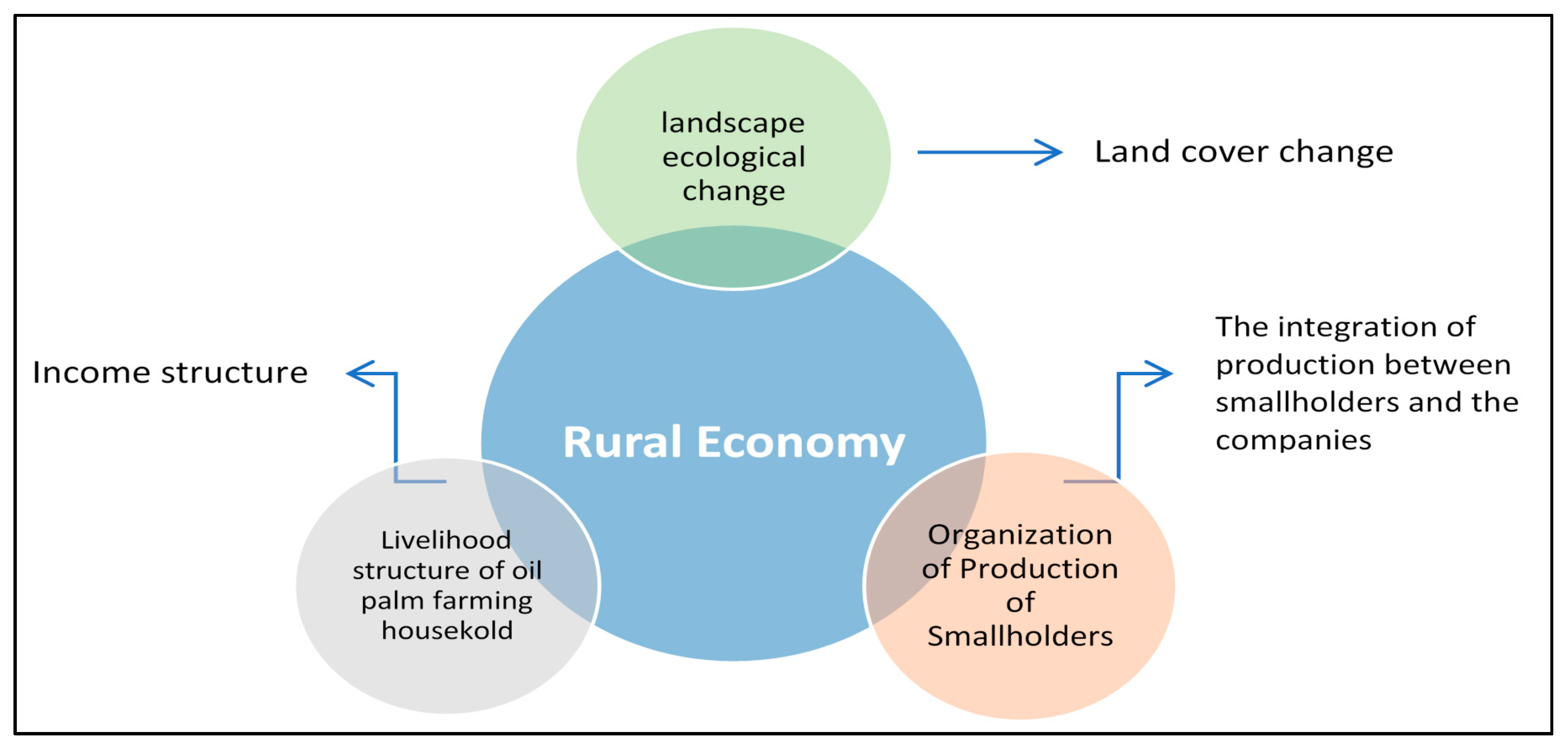
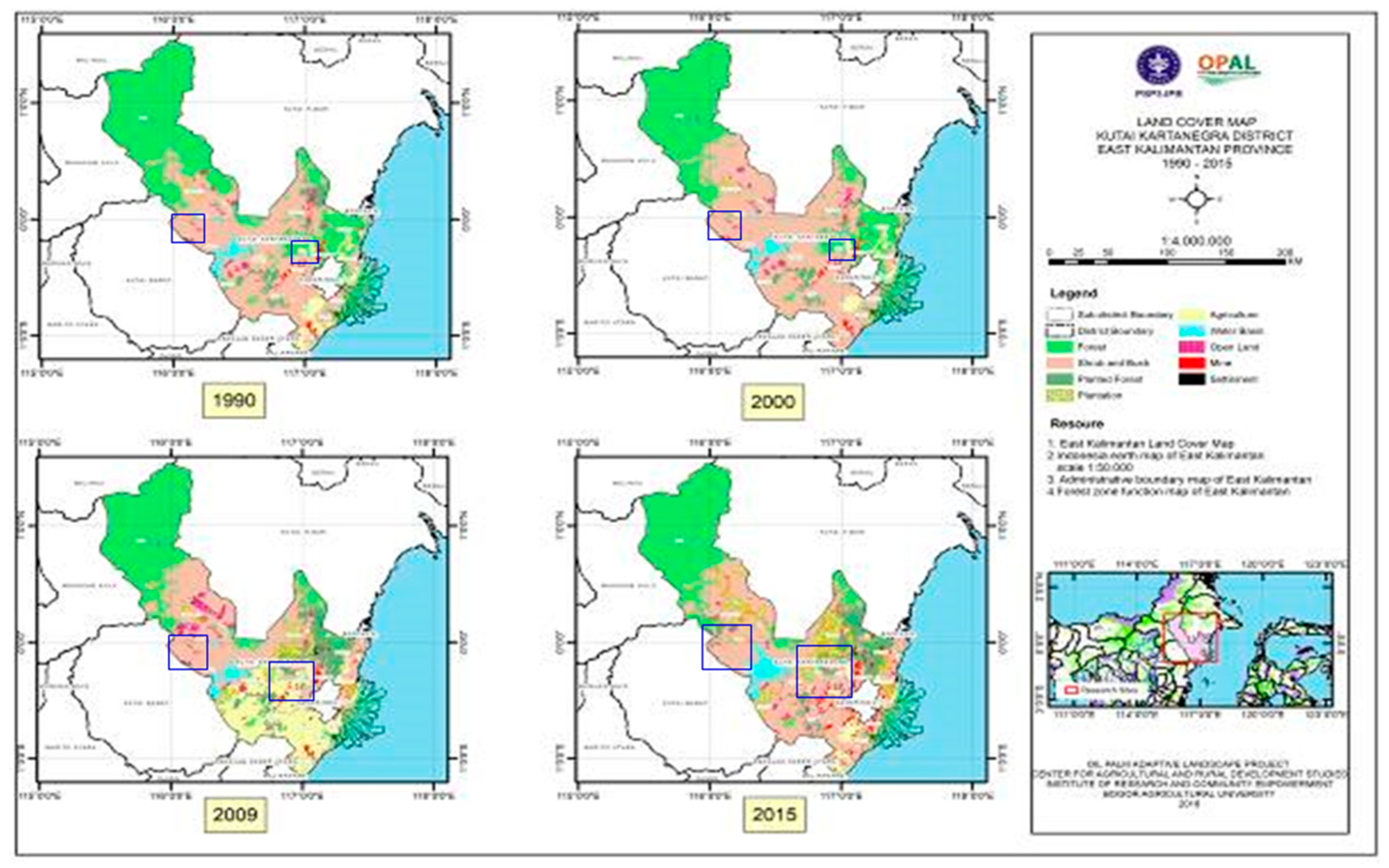
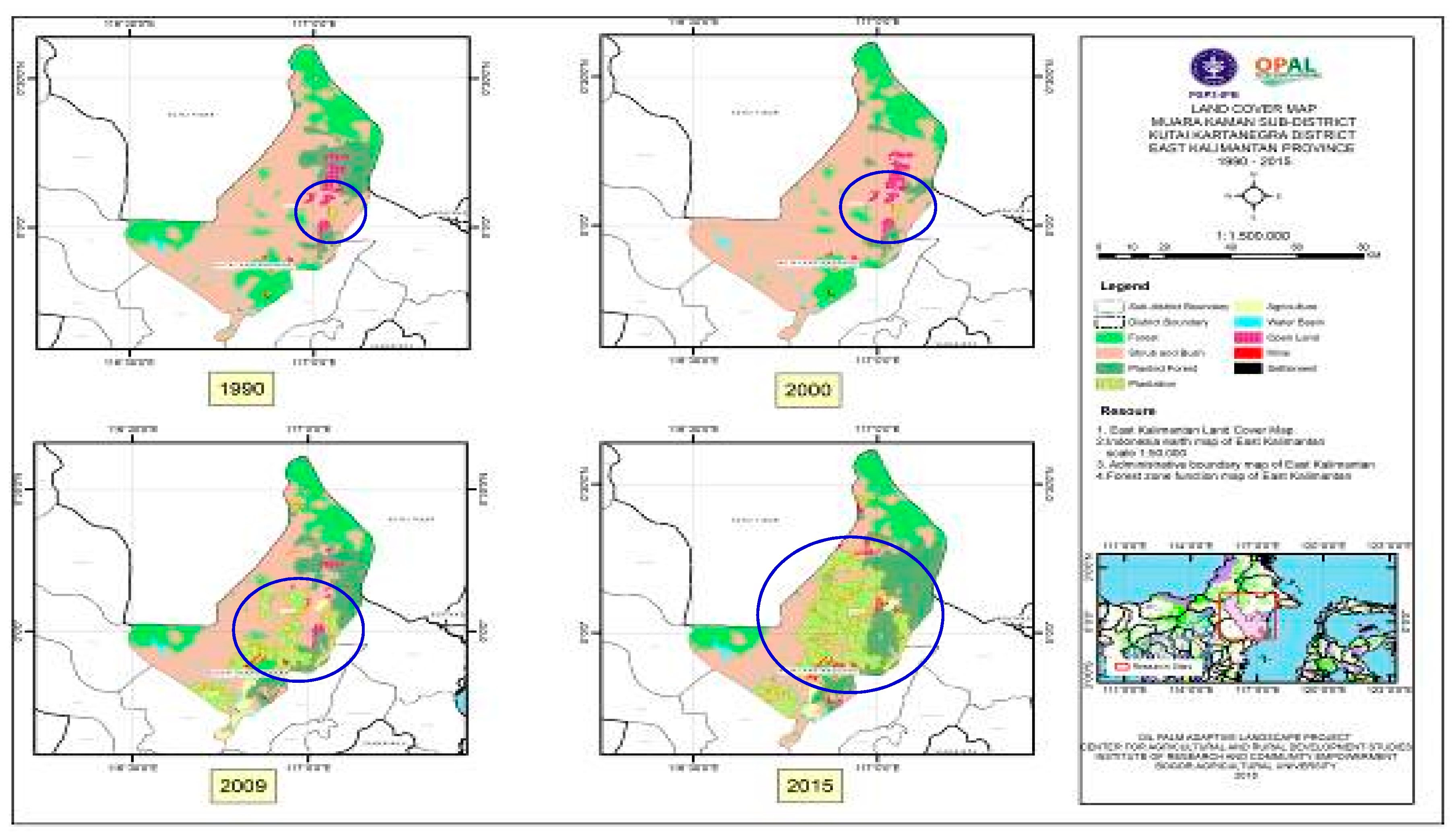
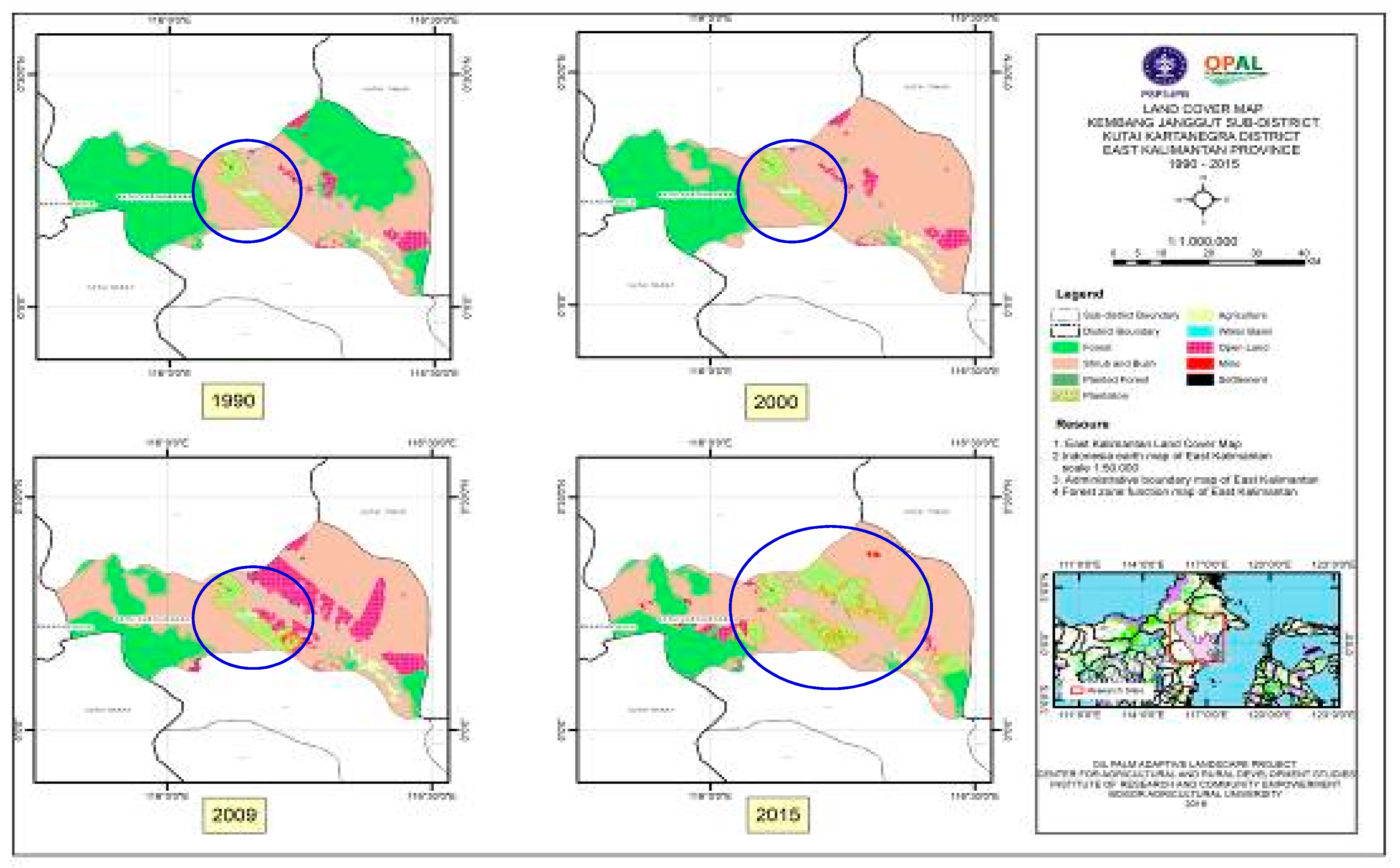
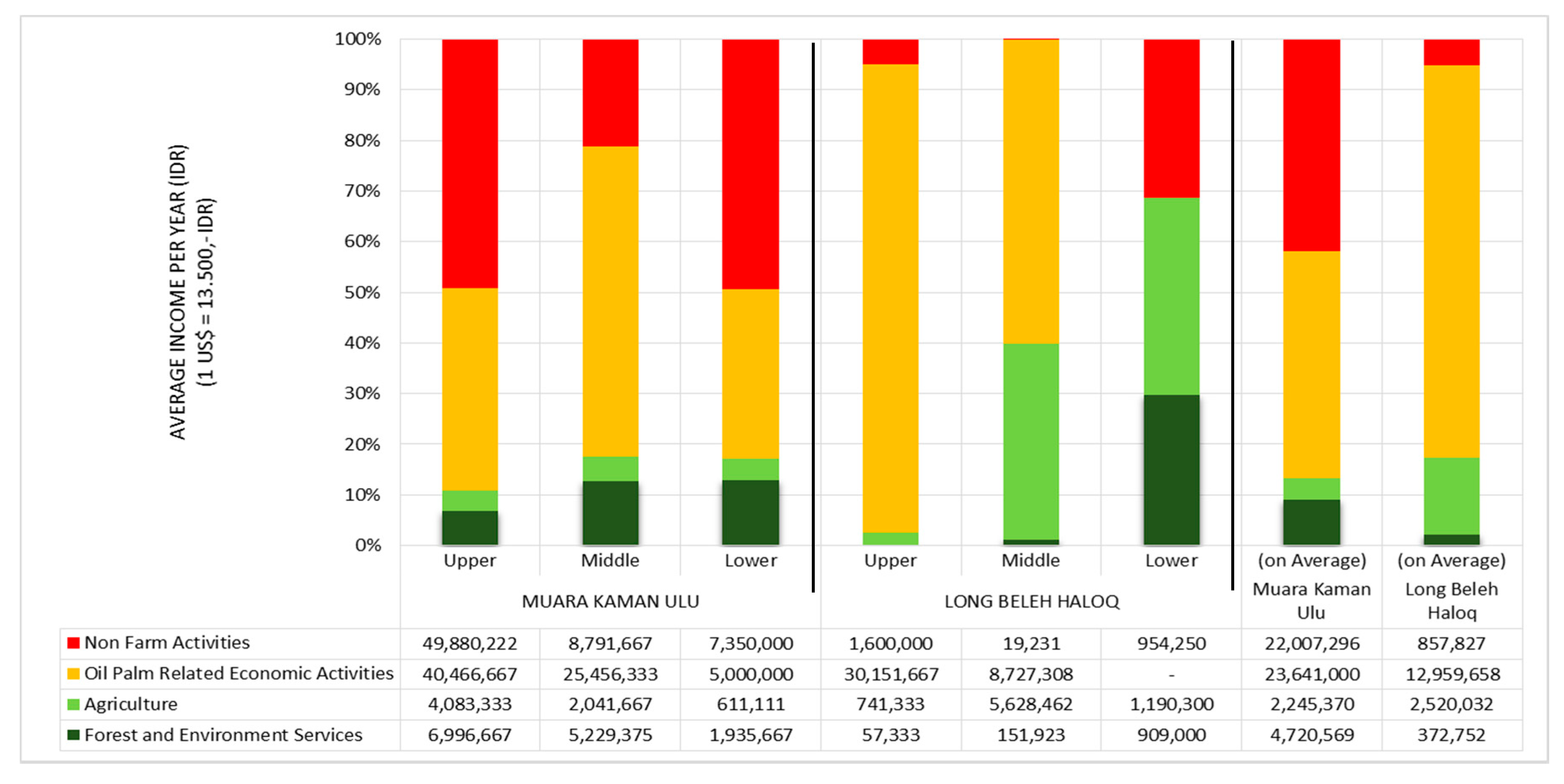
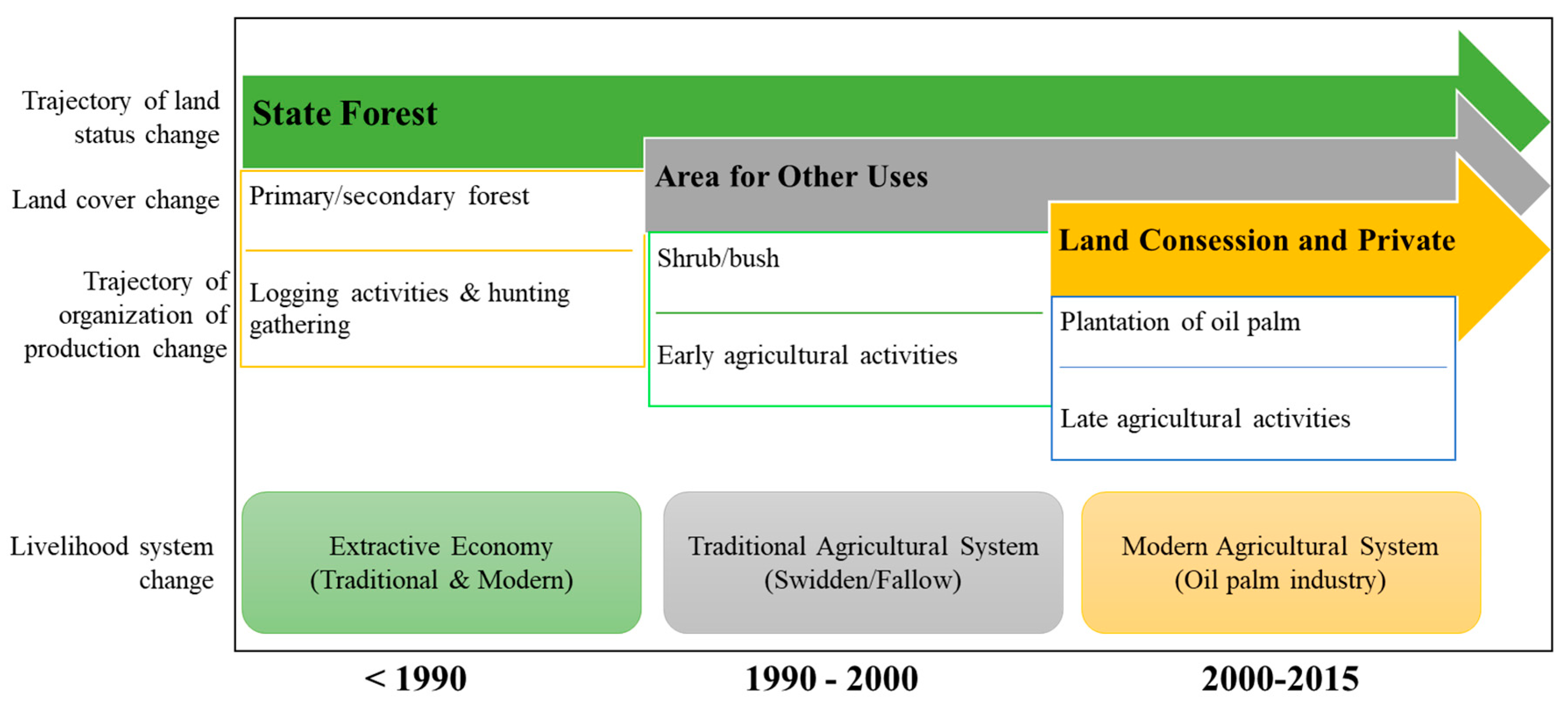
| No. | Research Locations (villages) | Simpson Diversity Index According to Income Structure of Farming Households of Different Strata, Counted in Indonesian Rupiah (IDR Per Year) | ||
|---|---|---|---|---|
| Upper (> 58,739,542) | Middle (24,543,099–58,739,542) | Lower (< 24,543,099) | ||
| 1. | Muara Kaman Ulu | 0.29 (n = 9) | 0.24 (n = 24) | 0.26 (n = 18) |
| 2. | Long Beleh Haloq | 0.03 (n = 15) | 0.02 (n = 13) | 0.14 (n = 20) |
| Household Income Diversity Index | High Diversity of Income Sources | Low Diversity of Income Sources | |
|---|---|---|---|
| Type of Oil Palm Expansion | |||
| Spotted expansion (e.g., oil palm expansion that is done by farming households of transmigration programs and independent smallholders). | √ | - | |
| Concentrated expansion (e.g., oil palm expansion that is done by independent plasma smallholders or NES smallholders). | - | √ | |
© 2020 by the authors. Licensee MDPI, Basel, Switzerland. This article is an open access article distributed under the terms and conditions of the Creative Commons Attribution (CC BY) license (http://creativecommons.org/licenses/by/4.0/).
Share and Cite
Dharmawan, A.H.; Mardiyaningsih, D.I.; Komarudin, H.; Ghazoul, J.; Pacheco, P.; Rahmadian, F. Dynamics of Rural Economy: A Socio-Economic Understanding of Oil Palm Expansion and Landscape Changes in East Kalimantan, Indonesia. Land 2020, 9, 213. https://doi.org/10.3390/land9070213
Dharmawan AH, Mardiyaningsih DI, Komarudin H, Ghazoul J, Pacheco P, Rahmadian F. Dynamics of Rural Economy: A Socio-Economic Understanding of Oil Palm Expansion and Landscape Changes in East Kalimantan, Indonesia. Land. 2020; 9(7):213. https://doi.org/10.3390/land9070213
Chicago/Turabian StyleDharmawan, Arya Hadi, Dyah Ita Mardiyaningsih, Heru Komarudin, Jaboury Ghazoul, Pablo Pacheco, and Faris Rahmadian. 2020. "Dynamics of Rural Economy: A Socio-Economic Understanding of Oil Palm Expansion and Landscape Changes in East Kalimantan, Indonesia" Land 9, no. 7: 213. https://doi.org/10.3390/land9070213
APA StyleDharmawan, A. H., Mardiyaningsih, D. I., Komarudin, H., Ghazoul, J., Pacheco, P., & Rahmadian, F. (2020). Dynamics of Rural Economy: A Socio-Economic Understanding of Oil Palm Expansion and Landscape Changes in East Kalimantan, Indonesia. Land, 9(7), 213. https://doi.org/10.3390/land9070213








